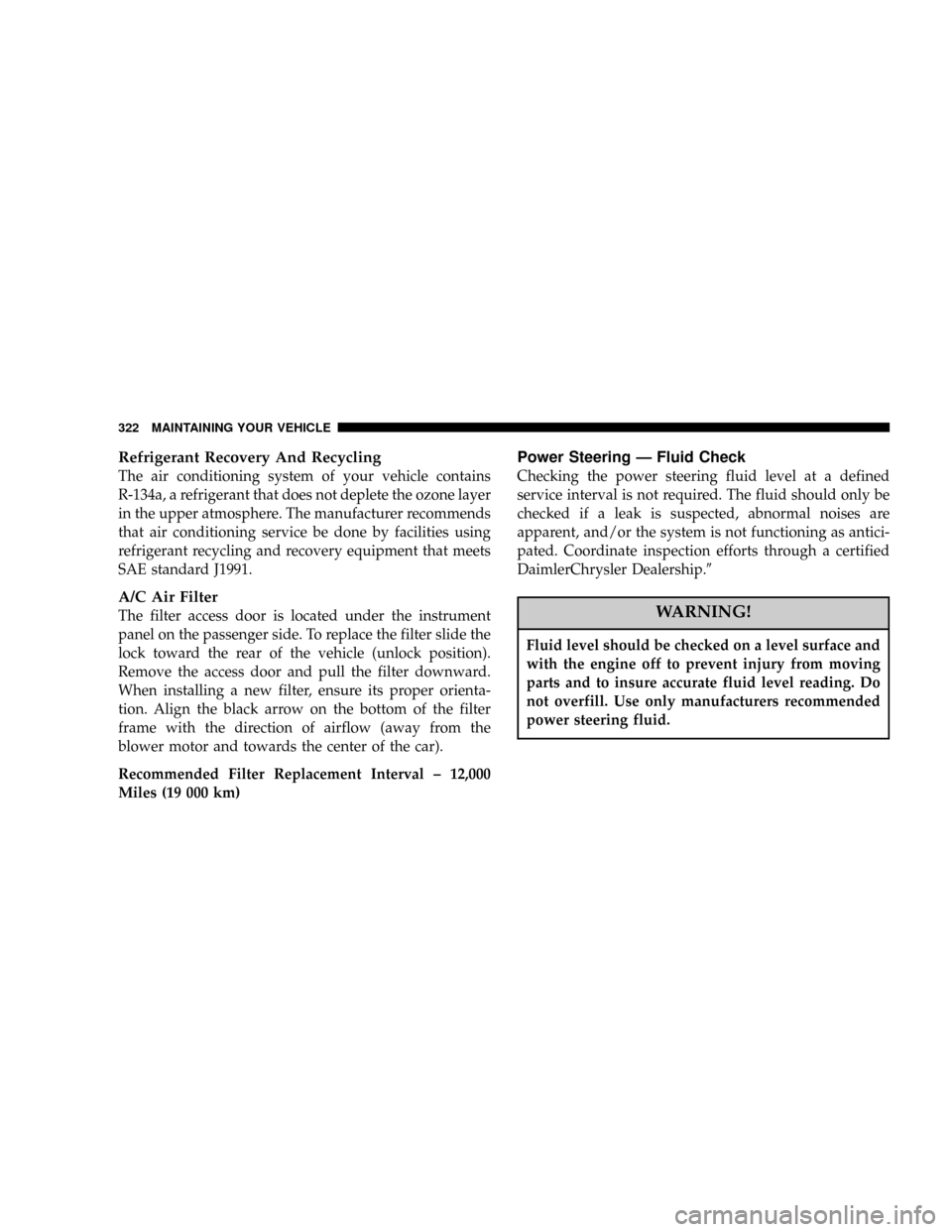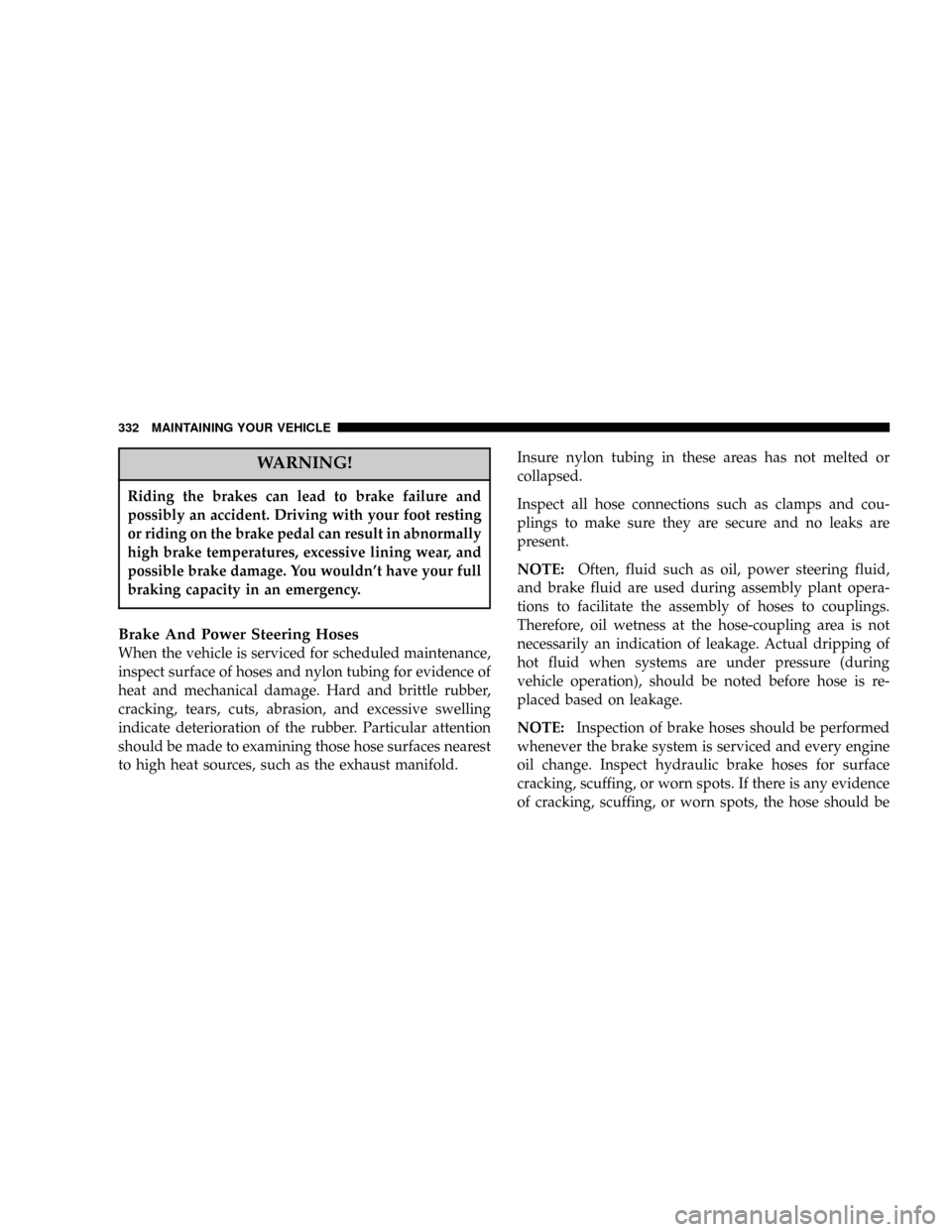Page 75 of 401
Lights
Have someone observe the operation of exterior lights
while you work the controls. Check turn signal and high
beam indicator lights on the instrument panel.
Fluid Leaks
Check area under vehicle after overnight parking for fuel,
engine coolant, oil or other fluid leaks. Also, if gasoline
fumes are detected or fuel, power steering fluid or brake
fluid leaks are suspected, the cause should be located and
corrected immediately.
THINGS TO KNOW BEFORE STARTING YOUR VEHICLE 75
2
Page 250 of 401
WARNING!
Continued operation with reduced power steering
assist could pose a safety risk to yourself and others.
Service should be obtained as soon as possible.
CAUTION!
Prolong operation of the steering system at the end
of the steering wheel travel will increase the steering
fluid temperature and should be avoided when
possible. Damage to the power steering pump may
occur.
TRACTION CONTROL Ð IF EQUIPPED
The Traction Control System reduces wheel slip and
maintains traction at the driving (front) wheels. The
system reduces wheel slip by engaging the brake on the
wheel that is losing traction (spinning). The system
operates at speeds below 35 mph (56 km/h).
The system is always in the ªstand byº mode unless,
²The Traction Control Switch has been used to turn the
system OFF
250 STARTING AND OPERATING
Page 305 of 401
MAINTAINING YOUR VEHICLE
CONTENTS
m3.3L/3.8L Engines......................308
mOnboard Diagnostic System Ð OBD II........309
mEmissions Inspection And Maintenance
Programs............................310
mReplacement Parts......................311
mDealer Service.........................311
mMaintenance Procedures..................312
NEngine Oil..........................313
NEngine Oil Filter......................316NDrive Belts Ð Check Condition And Tension . . 316
NSpark Plugs.........................317
NEngine Air Cleaner Filter................317
NEngine Fuel Filter.....................318
NCatalytic Converter....................318
NMaintenance-Free Battery................319
NAir Conditioner......................321
NPower Steering Ð Fluid Check............322
NFront Suspension Ball Joints..............323
7
Page 306 of 401

NSteering Shaft Seal....................323
NSteering Linkage......................323
NDrive Shaft Universal Joints..............323
NBody Lubrication.....................324
NWindshield Wiper Blades................324
NWindshield And Rear Window Washers.....324
NExhaust System......................325
NCooling System.......................326
NHoses And Vacuum/Vapor Harnesses.......331
NBrakes.............................331
NMaster Cylinder Ð ABS Brakes Brake Fluid
Level Check.........................333
NFuel System Hoses....................334NAutomatic Transmission................335
NAll Wheel Drive (AWD).................337
NFront And Rear Wheel Bearings...........339
NAppearance Care And Protection
From Corrosion......................339
NCleaning The Instrument Panel And Underseat
Cup Holders........................343
mIntegrated Power Module (IPM)............344
mVehicle Storage........................345
mReplacement Light Bulbs.................346
mBulb Replacement......................347
NHeadlights..........................347
NFront Park/Turn Signal And
Sidemarker Lights.....................348
306 MAINTAINING YOUR VEHICLE
Page 322 of 401

Refrigerant Recovery And Recycling
The air conditioning system of your vehicle contains
R-134a, a refrigerant that does not deplete the ozone layer
in the upper atmosphere. The manufacturer recommends
that air conditioning service be done by facilities using
refrigerant recycling and recovery equipment that meets
SAE standard J1991.
A/C Air Filter
The filter access door is located under the instrument
panel on the passenger side. To replace the filter slide the
lock toward the rear of the vehicle (unlock position).
Remove the access door and pull the filter downward.
When installing a new filter, ensure its proper orienta-
tion. Align the black arrow on the bottom of the filter
frame with the direction of airflow (away from the
blower motor and towards the center of the car).
Recommended Filter Replacement Interval ± 12,000
Miles (19 000 km)
Power Steering Ð Fluid Check
Checking the power steering fluid level at a defined
service interval is not required. The fluid should only be
checked if a leak is suspected, abnormal noises are
apparent, and/or the system is not functioning as antici-
pated. Coordinate inspection efforts through a certified
DaimlerChrysler Dealership.9
WARNING!
Fluid level should be checked on a level surface and
with the engine off to prevent injury from moving
parts and to insure accurate fluid level reading. Do
not overfill. Use only manufacturers recommended
power steering fluid.
322 MAINTAINING YOUR VEHICLE
Page 332 of 401

WARNING!
Riding the brakes can lead to brake failure and
possibly an accident. Driving with your foot resting
or riding on the brake pedal can result in abnormally
high brake temperatures, excessive lining wear, and
possible brake damage. You wouldn't have your full
braking capacity in an emergency.
Brake And Power Steering Hoses
When the vehicle is serviced for scheduled maintenance,
inspect surface of hoses and nylon tubing for evidence of
heat and mechanical damage. Hard and brittle rubber,
cracking, tears, cuts, abrasion, and excessive swelling
indicate deterioration of the rubber. Particular attention
should be made to examining those hose surfaces nearest
to high heat sources, such as the exhaust manifold.Insure nylon tubing in these areas has not melted or
collapsed.
Inspect all hose connections such as clamps and cou-
plings to make sure they are secure and no leaks are
present.
NOTE:Often, fluid such as oil, power steering fluid,
and brake fluid are used during assembly plant opera-
tions to facilitate the assembly of hoses to couplings.
Therefore, oil wetness at the hose-coupling area is not
necessarily an indication of leakage. Actual dripping of
hot fluid when systems are under pressure (during
vehicle operation), should be noted before hose is re-
placed based on leakage.
NOTE:Inspection of brake hoses should be performed
whenever the brake system is serviced and every engine
oil change. Inspect hydraulic brake hoses for surface
cracking, scuffing, or worn spots. If there is any evidence
of cracking, scuffing, or worn spots, the hose should be
332 MAINTAINING YOUR VEHICLE
Page 353 of 401
Chassis
Component Fluids, Lubricants and Genuine Parts.
Automatic Transmission MopartATF+4 Automatic Transmission Fluid.
AWD Power Transfer Unit MopartGear Lubricant 75W-90.
AWD Overrunning Clutch MopartATF+4 Automatic Transmission Fluid.
AWD Rear Carrier MopartGear Lubricant 75W-90.
Brake Master Cylinder MopartDOT 3 and SAE J1703 should be used. If DOT 3 brake fluid is not
available, then DOT 4 or DOT 4+ is acceptable. Use only recommended
brake fluids.
Power Steering Reservoir MopartATF+4 Automatic Transmission Fluid.
MAINTAINING YOUR VEHICLE 353
7
Page 390 of 401

Air Cleaner Filter...................... 317
Block Heater......................... 240
Break-In Recommendations................ 72
Checking Oil Level..................... 313
Compartment......................... 308
Coolant............................. 352
Cooling............................. 326
Exhaust Gas Caution..................37,278
Fails to Start.......................... 239
Fuel Requirements..................... 274
Oil ..............................313,352
Oil Change Interval.................... 314
Oil Selection.......................... 314
Oil Synthetic......................... 316
Overheating.......................... 291
Temperature Gauge..................... 164
Exhaust Gas Caution..............37,73,278,326
Exhaust System......................... 325
Exterior Folding Mirrors................... 82Filters
Air Cleaner.......................... 317
Air Conditioning....................230,322
Automatic Transaxle.................... 337
Engine Fuel.......................... 318
Engine Oil........................316,352
Engine Oil Disposal.................... 316
Flashers
Hazard Warning....................... 290
Turn Signal.....................168,348,350
Fluid Capacities......................... 351
Fluid Leaks............................. 75
Fluid Level Checks
Automatic Transaxle.................... 336
Brake............................... 353
Power Steering.....................322,353
Fog Light Service........................ 349
Fog Lights.......................... 110,349
Freeing A Stuck Vehicle................... 300
390 INDEX